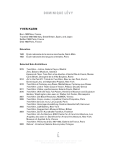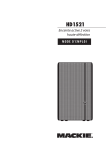Download User's Guide to Filling in the Ergonomic Risk Factor Checklist
Transcript
Revised April 1, 2011 Appendix I-C-3 User's Guide to Filling in the Ergonomic Risk Factor Checklist The purpose of this booklet is to provide an explanation of the content and use of the Ergonomics Risk Factor (ERF) Checklist. A checklist is only one part of an ergonomics analysis, and works best as a preliminary tool for observing a job and characterizing the levels of risk factors present within a job. A checklist does not provide answers, but instead provides a means of remembering what to analyze and an indication of what factors could be a problem within a job. The ERF checklist was created to address the situations found within an industrial manufacturing environment. The design of the ERF checklist emphasizes the identification of the combination of risk factors that occur most frequently in industry, and those associated with the highest magnitude of risk. The checklist is divided into three parts: risk factors for the upper extremity, risk factors for the back and lower extremity, and risk factors associated with manual materials handling. Within each of the parts, risk factors are assigned scores that increase with duration of exposure to each risk factor. To utilize the checklist, the analyst (you) must evaluate a work task or job to determine which, if any, risk factors are present and for how long each day the worker is exposed to each risk factor. The assigned scores for each combination of risk factor exposure/duration identified are added separately for the upper limb and the low back. Scoring risk factors for the upper limb and the low back are kept separate because simultaneous exposure to an upper extremity risk factor and a low back risk factor does not generally affect the same joint or anatomic region. General Instructions The following is a quick guide on how to perform an analysis using the ERF checklist. All components of the checklist should be filled out for each job or task to ensure that a full analysis has been performed. STEP 1 - Familiarize Yourself with the Job The first step in the analysis process is to familiarize yourself with the job. The two key ways to do this is through observation and interview. Stand back and watch the person perform the job for a few minutes; you are trying to get a feel for the range of activities that the person must perform in a day. To ensure that you are seeing everything that the person does, talk with the worker and ask them some questions about their job. Once you have observed the job and interviewed the worker, you should now complete the Ergonomics Analysis Worksheet. You do not have to fill these spaces, and you may need room to add more information later. Within Job Description you should try and describe the job on two levels: general and specific. The general description should detail the goals and duties that are involved with this job; this will provided a base for understanding why the person is performing various duties. The specific description should break down a job into the actions that are required to perform it. For instance: pick up part A from bin B and place on table C. These statements describe the general movements of the Community Ergonomic Plan 1 Revised April 1, 2011 person and the sequencing of these movements. The Comments you make about a job should provide additional, useful pieces of information that do not fit within the structure of the checklist, and may be relevant for further analyses. Within this section, you can make general remarks about the workstation, environment, job, or worker. You may want to include any measurements that you were able to perform (e.g. mass, dimensions, temperature, etc.). You could also include information pertaining to the anthropometries (body, size and type) of the person, and how well this matches with the workstation. Upon completion of the risk factor analyses (Steps2-4), you could also comment on which parts of the task tended to contain which risk factors (i.e. was there any specific task that was causing trouble?) The goal of an ergonomic analysis is to ensure that the job fits the worker. Therefore, the input on the person performing the job is a key part of the analysis. To fill out the Worker Interview portion of the checklist, you must talk with the person and gain their insight into the daily workings of the job. Some questions that could provide some useful information are: Could you explain what you do for me? Is this what you do all day, or do your duties change at any time? If you could improve this job in any way, what would you change? Do you feel any aches, pains, etc., that you feel are related to your job? If YES, what parts of your job are a problem to you? STEP 2 - Determine What Risk Factors are Present The next step within the checklist analysis is to determine what risk factors the person is being exposed to over the course of a day. If you look at these pages, you will note that the checklist is divided into columns; you will be filling out the column with the title Exposure. The exposure column contains simple yes/no questions, requiring you to answer whether or not the person is being exposed to the various risk factors described in each row. REMEMBER, you should have read and understood the risk factor definitions before you attempt to perform this step in the analysis, or any further ones. You should look at each risk factor, and observe the job to determine if the person is exposed to this factor at any time. If exposure exists, enter a YES; if the risk factor does not occur within this job, then check off NO. Once you have addressed all of the risk factors, then you can move on to Step 3. STEP 3 - Determine the Duration of Exposure to the Risk Factors In Step 2, you determined WHAT the person is being exposed to. Now, you must determine HOW LONG (Time column) the person is exposed to each risk factor. For every risk factor that you recorded a YES for in Step 2, you will now evaluate the length of time that the person is exposed to this factor. The risk factors that were found not present for this job, and were checked NO in Step 2, can be ignored in Step 3. The duration of exposure you are measuring here is not how long a person does a job, but instead how long the person does what is described as a risk factor. As an example: 2 Community Ergonomic Plan Revised April 1, 2011 Joe performs a job on a production line that has a cycle time (or job cycle) of 60 seconds; he does this job for 8 hours per day. For 45 seconds of every cycle, Joe works with his wrist deviated. For 20 seconds of every cycle, Joe's elbow is above mid-torso level. For 5 seconds of every cycle, Joe is bent forward greater than 45°. The easiest way to look at this job is to consider the job cycle to be representative of the entire day (i.e. whatever Joe does for 60 seconds, he does for 8 hours). Therefore, if Joe's wrist is deviated for 30 seconds every cycle, then through simple math (45/60 = 0.75), Joe spends % of his day or 6 hours with his wrist deviated. You would then give Joe a score of 3 for wrist deviation. Using the same format, you can calculate that Joe spends approximately 3 hours per day with his elbow above mid-torso level, and less than 1 hour per day with his torso bent forward greater than 45°. These durations of exposure would result in a score of 2 for shoulder posture and a score of 1 for trunk posture Regardless of the length of work cycle, the principal is the same for determining duration of exposure. All that you have to remember is that you are measuring how long the person is exposed to the individual risk factor, and this does not always correspond to the actual duration of the job. Once you have determined the duration of exposure for a risk factor, and have determined the score that corresponds to this exposure, you should then circle this score in the appropriate column and write down this score in the far right column. When you have completed both the Upper Limb and the Back & Lower Extremity Checklists, look over each checklist to ensure that every risk factor that has a YES in the Exposure column has a score in Time column. Additionally, every risk factor that was checked NO in the Exposure column should have no score in the Time column. Once you have completed this task, you can now go on to Step 4. STEP 4 - Evaluation of Manual Materials Handling The Manual Materials Handling (MMH) checklist is designed to evaluate the risk factors associated with lifting and carrying materials. The MMH checklist focuses on such variables as the location of the item being the lift, the mass of the item, how often the items is lifted, and the posture of the person while handling the item. To perform this analysis, the MMH checklist guides you through 3 distinct steps. The first step in the analysis is to determine the Horizontal Distance of the load from the body. The distance is divided into 3 categories: near (0 to 4 inches), middle (4 to 10 inches), and far (more than 10 inches). These ranges refer to the distance from the toes of the person to the middle knuckle. The second step in the analysis is to estimate the Weight of the item being lifted. If an item is lifted every 10 minutes or less, then use the average weight of all the items being lifted. If more than 10 minutes pass between lifts, then use the heaviest weight that the person lifts. Once you have established the Weight of the item, you then combine this information with your estimate of Horizontal Distance to determine your score for Step II. For example: a job where a person lifts a 20 lb load at a middle distance from the body (4 to 10 inches) would receive a score of 3 points. If the person does not lift any item that are greater than 10 lbs, then a score of 0 would be given to this job. Community Ergonomic Plan 3 Revised April 1, 2011 The third steps in the MMH analysis is to evaluate the Other Risk Factors that are related to handling loads. This third step is completely separate from step II; therefore, even if the items being lifted are not above 10 lbs, you should still fill out this section. The procedure for filling out this section is similar to that of the Risk Factor checklists for the Upper Extremity and Back & Lower Extremity. Your first decision is with respect to duration of exposure: how often and how long do the MMH activities occur? If lifting is only occasional, and more than 10 minutes pass between lifts, then you will be choosing values from the first column titled Occasional Lifts. If the risk factor occurs with most lifts, and lifting occurs for more than 1 hour, then you will be using the values from the second column titled Frequent Lifts. Once you have determined which column you will be using, your next task is to review each risk factor and determine whether or not the person is exposed to this factor. If the person is exposed to the factor, then circle the score in the appropriate column and transfer this value to the far right column. Once you have evaluated all of the risk factors, add up the scores in the right hand column and place the total in the box marked STEP III SCORE. The MMH checklist is really a component of the Back & Lower Extremity checklist. As such, the scores you obtain from the MMH checklist are recorded within the Back & Lower Extremity checklist, and contribute to the total score in this checklist. Once you have completed the MMH checklist, add up your scores from Steps II & III and record this value in the second last row of the Back & Lower Extremity checklist. You are now ready to move on to STEP 5 of the analysis. STEP 5- Add up the Checklist Scores The next step in the analysis is to determine the Total Scores for the Upper Limb and Back & Lower Extremity Checklists. All that is required here is to add up the scores in the far right column for each of the checklists, and record the total at the bottom of each checklist. STEP 6 - Opportunities for Improvement The final stage of the analysis is to record any actions that you feel could be performed to improve the job. After observing the job, talking with the worker, and performing the checklist analysis, are there any recommendations that you can make? You could recommend that certain aspect of the job be looked at in more detail before any decisions are made. The size and importance of your ideas are irrelevant; the key here is to record some ideas while you are there and the information is fresh in your head. Do some quick brainstorming, and try not to leave before you have written down at least 2 or 3 ideas. You can record your thoughts in the Comments section of the EAW. 4 Community Ergonomic Plan














